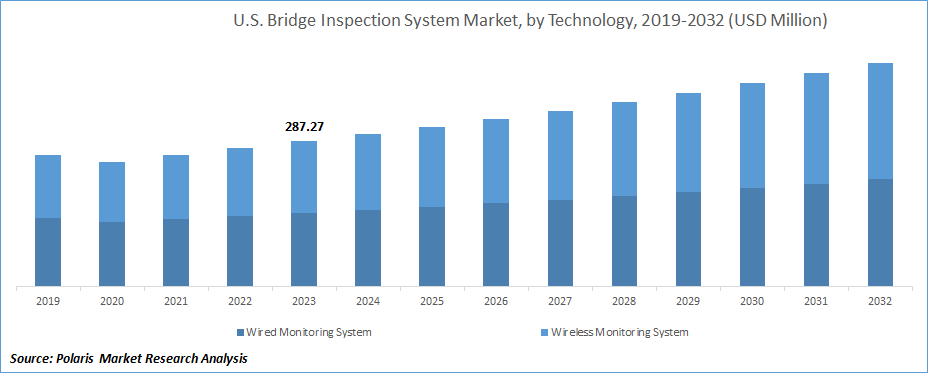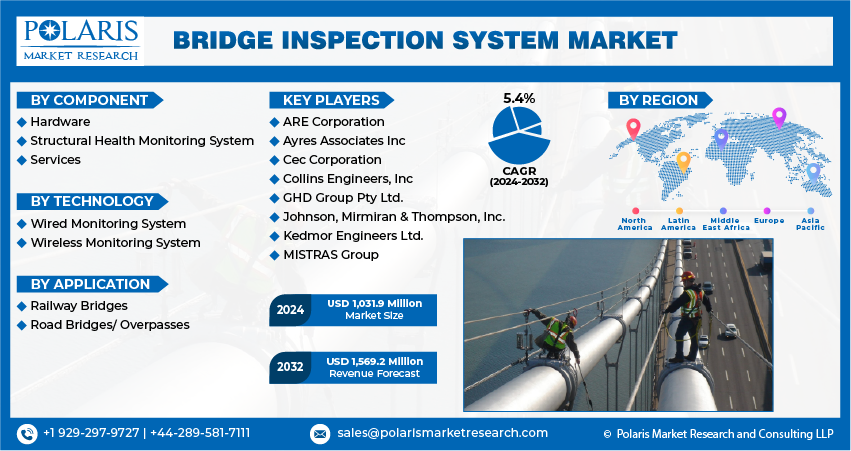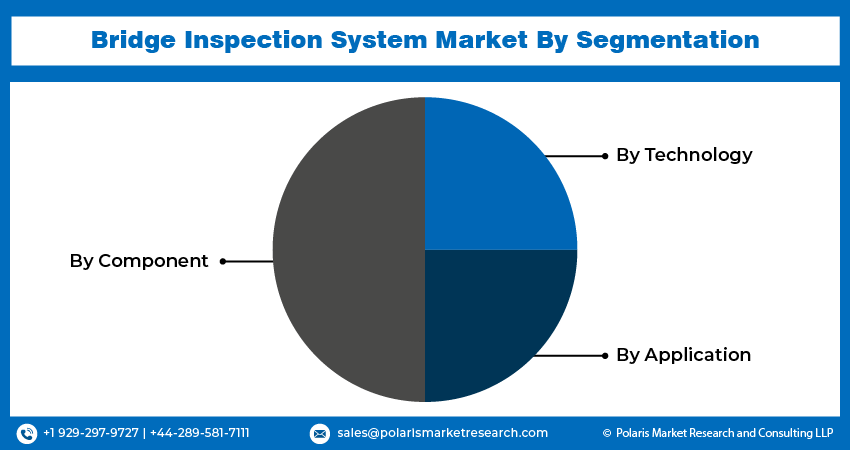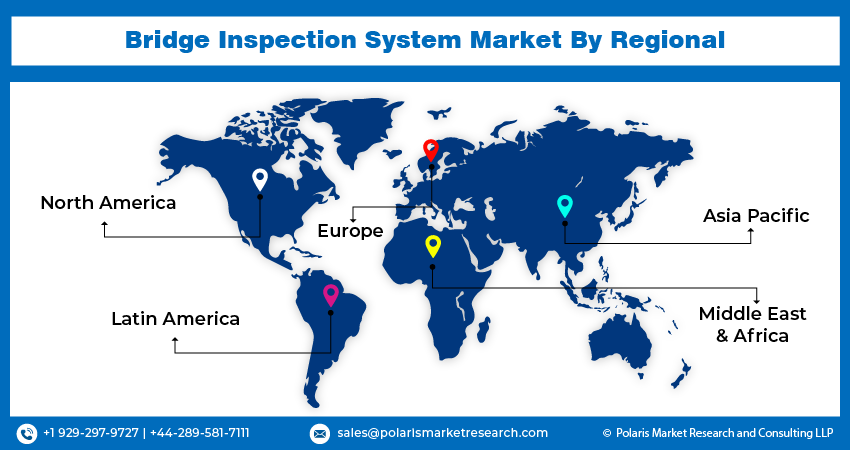
Bridge Inspection System Market Share, Size, Trends, Industry Analysis Report, By Component (Hardware, Structural Health Monitoring System, Services); By Technology; By Application; By Region; Segment Forecast, 2024 - 2032
- Published Date:Jun-2024
- Pages: 118
- Format: PDF
- Report ID: PM3332
- Base Year: 2023
- Historical Data: 2019-2022
Report Outlook
Bridge inspection system market size was valued at USD 980.0 million in 2023. The market is anticipated to grow from USD 1,031.9 million in 2024 to USD 1,569.2 million by 2032, exhibiting the CAGR of 5.4% during the forecast period.
Industry Trends
The global bridge inspection system market is experiencing significant growth, driven by the increasing need for regular and efficient monitoring of aging infrastructure. As bridges worldwide age and deteriorate, the importance of ensuring their safety and functionality becomes paramount. This has led to a surge in demand for advanced bridge inspection systems, which utilize cutting-edge technologies such as drones, robotics, and sensors. These systems offer more accurate, comprehensive, and timely data compared to traditional manual inspection methods, thereby enhancing the ability to detect and address potential structural issues before they become critical.

To Understand More About this Research:Request a Free Sample Report
Technological advancements are a key factor propelling the market forward. Innovations such as unmanned aerial vehicles (UAVs) equipped with high-resolution cameras and LiDAR (Light Detection and Ranging) technology allow for detailed visual and structural assessments without the need for extensive scaffolding or road closures. Additionally, the integration of artificial intelligence (AI) and machine learning (ML) in data analysis enables predictive maintenance by identifying patterns and anomalies that might indicate future problems. These technological improvements not only increase the efficiency and safety of bridge inspections but also reduce costs and downtime associated with traditional inspection methods.
Growing urbanization and infrastructure development are significant drivers propelling the bridge inspection system market forward. As urban areas expand and infrastructure networks evolve, the demand for efficient transportation systems, including bridges, increases substantially. This surge in infrastructure development necessitates robust inspection systems to ensure the safety, reliability, and longevity of bridge assets. Rapid urbanization leads to higher traffic volumes and heavier loads on existing bridge infrastructure, accelerating wear and tear and highlighting the need for regular monitoring and maintenance. Additionally, as cities strive to enhance connectivity and mobility, new bridge construction projects become increasingly common, further driving demand for inspection systems to assess the integrity of newly built structures.
Key Takeaways
- North America dominated the market and contributed over 33% market share of the bridge inspection system market size in 2023
- By component category, hardware segment dominated the global bridge inspection system market size in 2023
- By technology category, the wireless monitoring system segment is projected to grow with a significant CAGR over the bridge inspection system market forecast period
What are the market drivers driving the demand for market?
Growing Demand for Cost-Effective Maintenance Solutions
The increasing demand for cost-effective maintenance solution is a significant driver propelling the bridge inspection system market forward. As infrastructure ages and budgets tighten, there's a growing emphasis on optimizing maintenance strategies to maximize the lifespan of bridges while minimizing operational costs. Bridge inspection systems play a crucial role in this endeavor by offering efficient and proactive approaches to maintenance. By leveraging advanced technologies such as remote sensing, drones, and data analytics, these systems enable predictive and condition-based maintenance practices. Instead of relying solely on periodic inspections, which can be costly and time-consuming, bridge owners and operators can monitor structural health in real-time, identifying potential issues before they escalate into costly repairs or structural failures.
Furthermore, by implementing cost-effective maintenance solution, such as targeted repairs and preventive maintenance, bridge owners can extend the service life of their assets and reduce overall lifecycle costs. This not only ensures the safety and reliability of bridges but also optimizes resource allocation and budget utilization.
Which factor is restraining the demand for the market?
High Initial Investment
The high initial investment required for implementing bridge inspection systems poses a significant challenge to the market's growth and adoption. Procuring the necessary equipment, technology, and software solutions, along with associated training and infrastructure, represents a substantial upfront cost for organizations and government agencies. For smaller entities with limited budgets, such as local municipalities or transportation departments, the financial barrier to entry can be particularly daunting. They may struggle to justify the investment or secure adequate funding for implementing comprehensive inspection systems, especially when competing with other infrastructure priorities.
Moreover, the complexity and variability of bridge inspection requirements across different regions and jurisdictions further complicate the investment decision-making process. Customization and adaptation of inspection systems to meet specific regulatory standards and operational needs can drive up costs and increase uncertainty for prospective buyers.

Report Segmentation
The market is primarily segmented based on component, technology, application, and region.
|
By Component |
By Technology |
By Application |
By Region |
|
|
|
|
To Understand the Scope of this Report:Speak to Analyst
Category Wise Insights
By Component Insights
Based on component category analysis, the market has been segmented on the basis of hardware, structural health monitoring system, and services. In 2023, hardware components held the largest market share in the bridge inspection system market due to their foundational role in inspection operations. These components include sensors, cameras, drones, and data acquisition units, essential for collecting data on bridge conditions. As bridge inspection relies heavily on physical equipment for data capture and analysis, hardware components are indispensable. Additionally, advancements in sensor technology and the proliferation of drones have further boosted the demand for hardware, driving its dominance in the market.
In the bridge inspection system market, hardware components play a vital role in ensuring the structural integrity and safety of bridges. Monitoring systems form the backbone, integrating various sensors for real-time data collection and analysis. Vibration sensors detect and measure bridge vibrations caused by traffic or environmental factors, aiding in identifying potential structural weaknesses. Displacement sensors monitor movements in bridge components, helping assess deformations and structural stability.
By Technology Insights
Based on technology category analysis, the market has been segmented on the basis of wired monitoring system and wireless monitoring system. Wireless monitoring systems are experiencing the highest compound annual growth rate (CAGR) in the bridge inspection system market due to several factors. Firstly, they offer flexibility and scalability, allowing for easier installation and adaptability to diverse bridge structures and environments. Additionally, wireless systems enable remote monitoring and data transmission, reducing the need for physical infrastructure and enabling cost-effective Technology. Moreover, advancements in wireless technologies, such as improved reliability and security, are driving their adoption for bridge inspection applications, contributing to their rapid growth rate.
In the market, wireless monitoring systems represent a cutting-edge technology that enables the remote and continuous monitoring of bridge structures without the need for physical cables. These systems employ wireless sensors strategically placed throughout the bridge to collect data on various parameters such as strain, temperature, vibration, and corrosion.

Regional Insights
North America
In the North American region, the bridge inspection system market is witnessing steady growth driven by aging infrastructure, stringent safety regulations, and increasing investment in transportation infrastructure upgrades. Government initiatives for infrastructure modernization and maintenance, coupled with advancements in inspection technologies like remote sensing and data analytics, are driving market expansion. Key players in the region are focusing on developing innovative solutions tailored to address specific challenges such as harsh weather conditions and heavy traffic loads. The demand for comprehensive inspection systems that ensure the safety and longevity of bridges continues to grow, fostering opportunities for market growth and development in North America.
Asia Pacific
In the Asia-Pacific region, the bridge inspection system market is experiencing rapid expansion driven by extensive infrastructure development, urbanization, and the need to ensure the safety and longevity of bridges. Governments across the region are investing heavily in transportation infrastructure projects, creating significant demand for advanced inspection technologies and services. With a large number of bridges reaching their design life and increasing traffic volumes, there's a growing focus on implementing efficient and comprehensive inspection systems. Key players are leveraging emerging technologies such as drones, artificial intelligence, and IoT to meet the region's diverse inspection needs, presenting abundant opportunities for market growth and development in Asia-Pacific.

Competitive Landscape
The competitive landscape of the market is characterized by a diverse array of players, including established engineering firms, technology innovators, and specialized inspection service providers. Leading companies leverage their extensive expertise in civil engineering and infrastructure management to offer comprehensive bridge inspection solutions. These firms often integrate advanced technologies such as drones, robotics, and AI-based analytics to enhance the accuracy and efficiency of inspections.
Some of the major players operating in the global market include:
- ARE Corporation
- Ayres Associates Inc
- Cec Corporation
- Collins Engineers, Inc
- GHD Group Pty Ltd.
- Johnson, Mirmiran & Thompson, Inc.
- Kedmor Engineers Ltd.
- MISTRAS Group
Recent Developments
- In November 2023, GHD has been awarded the prime consultant role for both the Lewiston-Queenston Bridge and Rainbow Bridge rehabilitation projects. These structures that connect Canada and the United States are vital economic trade routes, which Niagara Falls Bridge Commission (NFBC) has trusted company to rehabilitate, extending their serviceable life. GHD will oversee detailed design, administration, and contract inspection, partnering with renowned bridge construction and preservation experts Greenman-Pedersen Incorporated (GPI) to deliver the work.
- In January 2022, CEC announces the acquisition of white engineering in Oklahoma this combination will help in structuring civil engineering, construction engineering and inspection, materials testing, surveying and mapping and power delivery.
- In July 2021, Collins Engineers, Inc. (Collins) performed the biennial inspection of a unique type of border bridge located between Wisconsin and Minnesota. The St. Croix Crossing Bridge has an extradosed design and is so unique that there are only a handful of bridges in the entire United States of this type of construction. Collins’ inspection teams used a combination of traditional and innovative inspection techniques to successfully document the current condition of the bridge as well as provide insight into the future of structural evaluations.
- In March 2021, Collins Engineers is working with the Minnesota Dept. of Transportation on the restoration of the James J. Hill Stone Arch Bridge in Minneapolis. The 19th-century masonry structure is due for repairs, and Collins has been using Microsoft HoloLens headsets with software from Bentley Systems to speed inspection work during the design phase.
Report Coverage
The bridge inspection system market report emphasizes on key regions across the globe to provide better understanding of the technology to the users. Also, the report provides market insights into recent developments, trends and analyzes the technologies that are gaining traction around the globe. Furthermore, the report covers in-depth qualitative analysis pertaining to various paradigm shifts associated with the transformation of these solutions.
The report provides detailed analysis of the market while focusing on various key aspects such as competitive analysis, component, technology, application, and their futuristic growth opportunities.
Bridge Inspection System Market Report Scope
|
Report Attributes |
Details |
|
Market size value in 2024 |
USD 1,031.9 million |
|
Revenue forecast in 2032 |
USD 1,569.2 million |
|
CAGR |
5.4% from 2024 – 2032 |
|
Base year |
2023 |
|
Historical data |
2019 – 2022 |
|
Forecast period |
2024 – 2032 |
|
Quantitative units |
Revenue in USD million and CAGR from 2024 to 2032 |
|
Segments covered |
By Component, By Technology, By Application, By Region |
|
Regional scope |
North America, Europe, Asia Pacific, Latin America; Middle East & Africa |
|
Customization |
Report customization as per your requirements with respect to countries, region and segmentation. |
FAQ's
The bridge inspection system Market report covering key segments are components, technology, application, and region.
Bridge Inspection System Market Size Worth USD 1,569.2 Million by 2032
Bridge inspection system market exhibiting the CAGR of 5.4% during the forecast period.
North America is leading the global market.
The key driving factors in bridge inspection system Market are Growing Demand for Cost-Effective Maintenance Solutions
